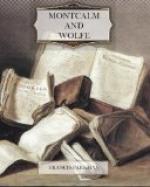[Footnote 546: De Gaspe, Memoires, 119.]
The chief Canadian families were so social in their habits and so connected by intermarriage that, along with the French civil and military officers of the colonial establishment, they formed a society whose members all knew each other, like the corresponding class in Virginia. There was among them a social facility and ease rare in democratic communities; and in the ladies of Quebec and Montreal were often seen graces which visitors from France were astonished to find at the edge of a wilderness. Yet this small though lively society had anomalies which grew more obtrusive towards the close of the war. Knavery makes strange companions; and at the tables of high civil officials and colony officers of rank sat guests as boorish in manners as they were worthless in character.
Foremost among these was Joseph Cadet, son of a butcher at Quebec, who at thirteen went to sea as a pilot’s boy, then kept the cows of an inhabitant of Charlebourg, and at last took up his father’s trade and prospered in it.[547] In 1756 Bigot got him appointed commissary-general, and made a contract with him which flung wide open the doors of peculation. In the next two years Cadet and his associates,Pean, Maurin, Corpron, and Penisseault, sold to the King, for about twenty-three million francs, provisions which cost them eleven millions, leaving a net profit of about twelve millions. It was not legally proved that the Intendant shared Cadet’s gains; but there is no reasonable doubt that he did so. Bigot’s chief profits rose, however, from other sources. It was his business to see that the King’s storehouses for the supply of troops, militia, and Indians were kept well stocked. To this end he and Breard, naval comptroller at Quebec, made a partnership with the commercial house of Gradis and Son at Bordeaux. He next told the Colonial Minister that there were stores enough already in Canada to last three years, and that it would be more to the advantage of the King to buy them in the colony than to take the risk of sending them from France.[548] Gradis and Son then shipped them to Canada in large quantities, while Breard or his agent declared at the custom-house that they belonged to the King, and so escaped the payment of duties. Theywere then, as occasion rose, sold to the King at a huge profit, always under fictitious names. Often they were




